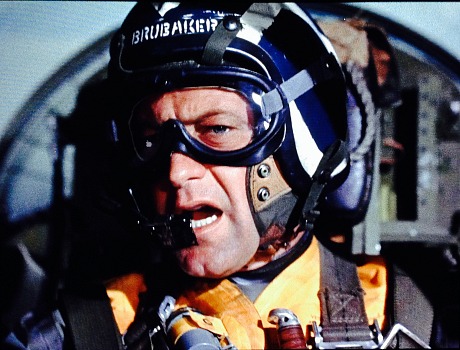I’ve watched Mark Robson‘s The Bridges at Toko-Ri (’54) four or five times since the mid ’90s. I’m a fan for several reasons but one of the biggest is Loyal Griggs‘ richly Technicolored, perfectly lighted cinematography. But I’d never seen it in high-def until renting it last night on Vudu, and lo and behold this December 1954 release hasn’t been whacked down to 1.66 or 1.85, as per custom when ’50s films get remastered for high-def or Bluray presentation. Boxy is beautiful on its own terms, of course, but 1.37 renderings of high-def, sharply focused 1950s Technicolor…heaven.

William Holden as Lt. Harry Brubaker in Mark Robson’s The Bridges at Toko-Ri, a Paramount release that opened in December 1954.
Toko-Ri‘s lustrous, high-end appearance suggests it was shot in VistaVision, but it was captured in straight 35mm. It was clearly framed to protect a 1.37 aspect ratio with allowances for possible theatrical matting to 1.66, the aspect ratio that its distributor, Paramount Pictures, had been endorsing at the time. The studio was actually in the throes of changing over from 1.66 to 1.85 aspect ratios in December ’54. (Its first 1.66:1 VistaVision release, White Christmas, opened in January ’54.) Should this film ever appear on Bluray (which doesn’t seem especially likely), this history could be used by the 1.85 fascists to justify cleavering The Bridges at Toko-Ri down to 1.85 or at least 1.66.
And yet all through last night’s viewing I was trying to imagine the tops and bottoms whacked off and it just didn’t seem aesthetically feasible. There are closeups of William Holden and Charles McGraw‘s faces as they sit in their jet cockpits with their helmets on — slicing these images would strike me as rash, to say the least. The usual cleavered claustrophobia. But then a severe sense of visual restriction is par for the course for this perverse bunch.
Consider what DVD Talk‘s Glenn Erickson wrote when the Bridges at Toko-Ri DVD came out twelve years ago: “Toko-Ri is presented in flat 4 x 3, but looks far better matted off to 1:78 on a widescreen television. There are always acres of space below the action, and the picture would have been sharper and bigger-looking if presented 16:9, in adapted 1:66.” The myopia! The skewed values! Bridges looks right as rain at 1.37. Every image breathes as it should. Grigg’s cinematography is a perfect expression of the headroom aesthetic — not “acres” of space above and below but just enough to make it look and feel like an authoritative ’50s environment.
Columbia’s The Caine Mutiny, another shipboard war drama which came out in June 1954, was filmed by dp Franz Planer with the same allowance for a boxy aesthetic. And yet for the 2011 Bluray Sony’s Grover Crisp chose to mask Edward Dmytryk‘s film at 1.85 — historically defensible given records that indicate that the film was intended to be exhibited at 1.85, and yet an appalling decision all the same because of those wonderful boxy framings and all that luscious headroom that was needlessly sacrificed. You’ll never convince me that Planer wasn’t in love with those 1.37 framings. Am I going to believe Grover Crisp’s research or my lying eyes?
I’d probably be smart to purchase Vudu’s boxy Bridges. If and when it goes to Bluray the fascists will step and demand a 1.66 a.r. if not 1.85 so I’d better get it while the getting is good.

